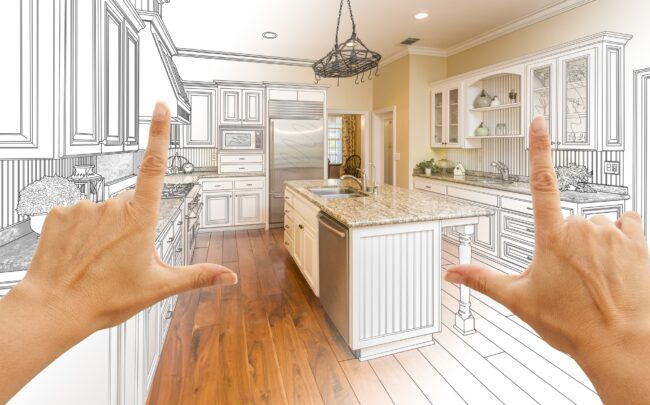Today’s housing market is a scary proposition for some homeowners. You can sell your home and make a considerable profit. Unfortunately, you’ll end up paying double or triple for a new place in some areas.
Even more intimidating, is trying to place a competitive offer against a property investor or someone open to a bidding war. Today, more homeowners are deciding to stay put and invest their home’s equity into a full home remodel.
It’s a great idea if you love your existing neighborhood and don’t want to move to a new city. However, remodeling your home is a significant endeavor and will take time and much consideration. Once you decide to go this route, there are a lot of decisions to make.
Even if this scenario is not your reason for an entire home remodel, we have you covered. Keep reading for our 16 tips to consider for a successful home remodeling project.
1. A Full Home Remodel Needs a Plan
The first step to renovating your home is to have a game plan. You want to give a lot of consideration to what you want to accomplish.
Start by making a wish list. Next, narrow it down to an in-reality list. Visit home remodeling websites for some inspiration. Also, visit websites like MilanBuild.com to check out their portfolios.
Once you’ve seen modern-day design concepts, you’ll have a starting point. Write down what you love and what you can live without in your existing home. Next, make a list of design concepts you would like to incorporate.
Now that you have a starting point, you can start a cost analysis to see how much it will cost.
2. Create a Budget
Create a budget for your full home remodel. Determine how you’re going to pay for it. The cost of materials has increased, so your home remodel today will cost more than it would have five years ago.
Take into consideration everything you’ll need to cover. There are materials, permitting, contractors, and more. You’ll also need to make allowances for unexpected expenses.
Do a worst-case analysis. Think of roadblocks you might experience.
For example, the wall you want to knock out could house a load-bearing beam. You might discover the plumbing may need to be torn out in the bathroom before you can proceed.
Hiring a home inspector is a good idea while working on your budget. The inspector can point of issues you never considered.
3. Seek Financing
Have you thought about how you’ll finance your home renovation? It would be great if you’ve saved up for the project. If not, you still have options. The most common way to fund a full home remodel is to use the home’s equity.
Equity is the difference between the amount owed on the mortgage and the home’s current market value. Thanks to rapidly rising home prices, now is a great time to refinance your mortgage.
Taking out equity in your home can increase your monthly mortgage. Make sure the new amount is within your budget.
Other financing options are to draw from your retirement plan, cash in stock, or take out a personal loan. It doesn’t hurt to have wealthy parents who can gift you the money.
4. Decide Where You’ll Stay
Depending on how massive your home remodel will be, you may have to consider relocating during the renovation. Housing can pose another considerable expense unless you can stay with relatives or friends.
If your home has enough room, you might have the option to leave in a portion of the home that isn’t getting work done. As one project concludes, you can move to another area.
Staying in the house can be inconvenient, but sometimes the cost-savings are too good to pass on. Take into consideration the impact on children and pets. Will relocating impact their schooling and other routines?
You might also want to space out renovating your home. Try remodeling the home in sections.
For example, in January, you can remodel the kitchen. Take a break and then start the bathroom in March. Going this route minimizes the inconvenience of not having full use of the home for long stretches.
5. Who Will Do the Work
Another big decision is deciding who will do the work. Some remodeling jobs are weekend DIY projects. You can gather a group of friends to help you get the job done.
Bigger, more labor intense home remodel projects will require licensed professionals. A part of planning out the remodel is making a realistic list of what you will do and what others will complete.
Anything you commit to doing yourself has to be re-evaluated. If the task is connected to a larger project, it can cause a scheduling conflict if you get off track. Once your project falls behind, it is almost impossible to get back on schedule.
In the whole scheme of things, leave it to the professionals if you’re not fully skilled at something.
6. Consult With an Architect
Home renovations requiring room additions or expanding existing rooms require architectural renderings. Architects can get expensive, so make sure you add this expense into the budget.
An architect can also show you better ways to get your desired results. What may seem like a great idea to you, the architect can explain why it may not work. They also look at the project in its totality.
You may want to expand the kitchen into the backyard. In your planning, you forgot there’s an oak tree in the required space that will need to get cut down.
That architect can also help with filing your plans and getting approval.
7. Interview Contractors
Chances are you’re going to hire contractors to renovate your home. People sometimes confuse general contractors with subcontractors. Most people can act as the contractor on a home remodel but here is why you shouldn’t.
General contractors (GC) are registered and licensed. They know codes and compliance laws for your area. Most importantly, they have relationships with general contractors.
You pay a GC to run the project and supervise the job site. If a portion of the work requires a permit, they will spend hours at the permit office waiting for approval. Plus, they know the code enforcement officers and building inspectors.
It’s good to have a knowledgeable GC on the project because they can see things you might miss. They also know how to communicate with the workers to keep them on task.
8. Research Permits
If your remodeling project involves plumbing, electrical, or roofing, chances are you’ll need to pull permits for the work. The city or county has the right to issue a stop-work order for unpermitted work.
Some agencies will go as far as to force homeowners to tear down unpermitted structures.
Do your research ahead of time to ensure you understand what requires a permit. If you don’t have the expertise or the time, hire a general contractor.
Permits are another line item on your budget. Call down to the permitting office to get a fee schedule in advance.
9. Set a Start Date
Your project is moving forward. Contractors are in place, you have the money in the bank, and materials are secured. It’s time to set a start date for the home renovation.
Choosing a start date requires careful consideration. Keep in mind the time of year. You want to choose the best weather for remodeling your home.
When contractors get backed up, it can negatively impact other projects. Try avoiding rainy months and months when it’s likely to snow.
You also want to confirm your start date with the contractors to ensure they have enough workers. If the plumber can’t start on time, it could delay the electrical work. Before you know it, you’re experiencing a domino effect.
Always have a plan B and never assume things will happen as planned.
10. Get a Storage Unit
It’s a smart idea to rent a storage unit to store furniture and other items while remodeling your home. The workers can move faster if they aren’t working around furniture and other household items.
By placing items in storage, you can protect them from damage.
Home remodels are also an excellent time to declutter. You may find there are items you no longer want. Or you may want to buy new furniture to go with your newly remodeled home.
11. Shop for Design Ideas
When considering a home renovation, you may not have a clear idea of design styles. Take some time to visit showrooms and design galleries to get some ideas. It’s also a great way to see designs from websites and magazines in person.
Designer showrooms have interior decorators who can help you bring your vision to life. You can sort through tile, flooring, hardware, and color schemes.
After the contractors have done their part, you’ll have to add the finishing touches. Know what you want before the project is finished.
12. Buy Materials
Home renovations differ from a new build. Buying materials for your home remodel is usually the homeowner’s responsibility. Most contractors only provide labor pricing, although some exceptions apply.
Bearing the responsibility to purchase materials can work in your favor. You assure that you’re getting the best pricing. You also get to choose the product manufacturer.
The downside is, you’re relying on the contractor for a material list. If they miscalculate, you could end up making daily trips to the store. Work slows down, and you’re soon off schedule.
13. Make Time for Relaxation
Renovating a home is a huge undertaking that can become stressful at times. Don’t feel bad about taking time away to relax and enjoy your family. If the budget allows, plan a few weekend getaways.
Also, don’t become so overwhelmed that you miss out on important events. The house will be there when you return. Go ahead and celebrate weddings, birthdays, and other occasions.
14. Hire a Professional Cleaner
Once the workers are done, they will clean up their mess. However, your remodeled areas may still require deep cleaning.
Research professional cleaners skilled in after-construction clean-ups. They will have the proper equipment to remove dust and other debris. They will also have the right cleaners to remove adhesives and excess caulking from surfaces.
You’ll feel much better are about setting up your new space if you are assured it’s clean. Plus, you’re guaranteed to breathe easier.
15. Set up Your New Living space
Once you’re satisfied with the home renovation and the place is thoroughly cleaned, it’s time to set up your home. Use this time to make sure you made the right paint and tile choices.
Hopefully, as the home was being remodeled, you could shop for updated artwork and new fixtures.
We can say for sure you will not be totally satisfied bringing your old stuff into your new spaces. Don’t rush it. Pick up new items as you go.
16. Host a Home Warming Party
Hopefully, renovating your home was worth the time, money, and experience. Now it’s time for a big reveal. Plan a re-home warming party to show off your new renovations.
Everyone is sure to be excited to see what you have done to your home. It’s also a great time to show appreciation to everyone that helped along the way.
Take family and friends on a tour of the updated spaces. When you’re finished, toast to new beginnings in your newly renovated home.
Work Smarter Not Harder on Your Home Remodel
A full home remodel doesn’t need to happen at once. It’s okay to pace yourself and complete one room at a time. If you’re opening spaces and changing the layout, do the complicated tasks first.
Don’t place too much pressure on yourself to meet every deadline. Remodeling always has obstacles that can set you back a few days, weeks, or even months. Take a breath and focus on the outcome.














